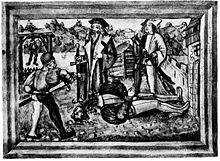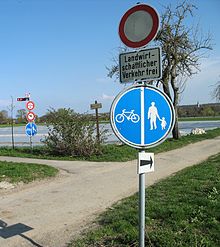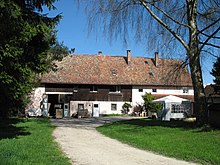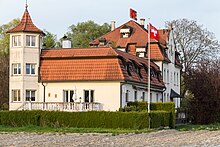Day moss
| Tägermoos (municipality of Tägerwilen ) |
|
|---|---|
| State : |
|
| Canton : |
|
| District : | Kreuzlingen |
| Political community : | Tägerwilen |
| Postal code : | 8274 |
| UN / LOCODE : | CH TWN |
| Coordinates : | 728.55 thousand / 280 219 |
| Height : | 397 m above sea level M. |
| Area : | 1.55 km² |
| Residents: | 66 (2010-12-31) |
| Population density : | 43 inhabitants per km² |
| Website: | www.taegerwilen.ch |
| map | |
The Tägermoos is an area of 1.55 km² in the canton of Thurgau in Switzerland between the outskirts of the German city of Konstanz and the center of the Swiss community of Tägerwilen . It is located on the southern bank of the Seerhein and borders the Constance district of Paradies to the east and the city of Kreuzlingen (district of Emmishofen ) to the southeast .
It has had a special status since 1831: although it belongs to Switzerland, the Tägermoos is a district of the German city of Constance: it performs certain administrative tasks.
Special status
The state treaty of March 28, 1831 explains the curious status of the area. According to the contract, the area belongs to Switzerland under constitutional law and to Tägerwilen at community level. However, the city of Konstanz exercises certain administrative tasks in Tägermoos in accordance with the Thurgau municipal law; others are carried out by the Tägerwilen authorities. In particular, the surveying and the cadastral system also fall under the responsibility of Konstanz, which makes the Tägermoos a district of Konstanz.
Statistically it is not managed by the Swiss Federal Statistical Office with its own area number, but under the BFS no. 4696 (Tägerwilen) counted. In accordance with this, the Tägermoos is not recorded by the Baden-Württemberg State Statistical Office .
Under private law, around two thirds of the land is owned by the city of Konstanz, the rest belongs to private individuals and Swiss authorities. Once a swampy common meadow (communal pasture ), the Tägermoos is now drained and is used as arable land with a focus on vegetable growing and allotment gardens. On the eastern edge of the Tägermoos are the community customs facility Tägermoos and a smaller border crossing ("Gottlieber Zoll").
At the community level, the tasks are divided between the city of Konstanz and the community of Tägerwilen.
Competence area Constance
The following areas fall within the competence of the City of Konstanz:
- Surveying and land registry by the town planning and surveying office, whereby the Tägermoos expressly forms a separate area of the city of Konstanz (§ 3 of the Tägermoos statute). This means that the Gauss-Krüger coordinate system common in Germany is used and not the Swiss national coordinates . The elevation system also differs from the system in the rest of Switzerland, which means that there is a surveying shoulder of 25 cm between Tägermoos and the rest of the municipality of Tägerwilen.
- Construction and maintenance of the country lanes (in the landscape you can see the dual responsibility on the traffic signs: the maximum speed sign on the main road Tägerwilen-Konstanz is Swiss, the driving prohibition signs with the note "residents free" at the entrances to the country lanes are German.)
- The punishment of “minor offenses” (§ 4).
- Supply of water and gas by the Stadtwerke Konstanz.
Competence area Tägerwilen
Tägerwilen's area of expertise includes the following tasks:
- Decide on building permits .
- Various administrative tasks that have been added since 1831. However, some lawyers are of the opinion that the increase in municipal tasks since the conclusion of the State Treaty has created a legal loophole.
There is also an exception in the state treaty for the taxation of properties: property owners who live in Konstanz do not pay any corresponding property tax or income tax to the municipality of Tägerwilen. For them, only the wealth tax of the Canton of Thurgau is levied on the corresponding property market value; Landowners residing in Thurgau are at least exempt from Swiss wealth tax.
Revision of the State Treaty
Regardless of these regulations, the legal historian Hans-Wolfgang Strätz takes the view that the Tägermoos statute gives the city of Constance de jure the status of a municipality of Thurgau with all rights and obligations, even if it does not exercise some of them.
In February 2006 the communities of Konstanz, Tägerwilen and Kreuzlingen announced that they wanted to revise the 175-year-old state treaty. This should create legal security for further construction projects in the area. Since the legal successors of the former contracting parties, the state of Baden-Württemberg and the canton of Thurgau , are no longer authorized to conclude state treaties of this kind, the change in legal status must take place at the level of the federal governments. On the Swiss side, a referendum must also take place in the affected communities.
history
Middle Ages and Early Modern Times

In the early Middle Ages, the Tägermoos belonged to the Thurgau property of the Diocese of Constance , the so-called Bischofshöri . Bishop Hermann I von Arbon (term of office 1138–1165) donated the area to the Schottenkloster Konstanz St. Jakob im Paradies, founded in 1142 . On August 31, 1294, the council and community of the city of Constance bought the meadows in Tägermoos from the Schottenkloster in order to use them as community pasture ( common land ). The use as pasture has been documented since the 13th century and did not change fundamentally until the privatization of the site after 1800. A gallows was erected on the pastureland outside the city walls in 1384 , which served as a place of execution until the 18th century (1833 he canceled). From 1446 there was also a municipal brickworks , later called "Ziegelhof", in which bricks were burned until the 19th century.
As a result of the Swabian War in 1499 with the battle in Schwaderloh , which stretched into Tägermoos and in front of the walls of Konstanz, the Free Imperial City of Konstanz lost the Thurgau district court, which it had held as pledge since 1417 (see also court lords in Thurgau ). From this point on, the Tägermoos was in hostile countries as seen from Konstanz. The lower jurisdiction over the Thurgau areas ( Vogtei Eggen , Raitigericht and the Altnau court ), including the Tägermoos, continued to be exercised by the city of Constance, while blood jurisdiction lay with the regional court in Frauenfeld in Thurgau . While the settlements in Paradies, then still called Eggenhusen , could be incorporated into Konstanz as early as the 14th century, the assignment of Tägermoos to the city district was not successful.
The paradise, located in the east of the Tägermoos, was provided with a fortification and a moat during the Thirty Years War , which formed a second defensive ring against attacks from the southern side of the Rhine. The Tägermoos itself was outside this ring, which was supposed to protect the settlements in Paradies and the “Brühl”, the urban festival meadow, against enemy attacks. From the “Äusseren Paradieser Tor”, the passage through the fortifications, the “Heerstrasse” led through the Tägermoos to Ermatingen .
Helvetization and privatization around 1800
With the collapse of the Old Confederation and the founding of the Helvetic Republic in 1798, a Swiss nation-state emerged, the boundaries of which were determined according to the former membership of the judge. The existing rights of the lower court lords on Swiss territory were curtailed; Only the high level of jurisdiction was decisive for the allocation to the national territory . In Tägermoos these were held by the Confederates since 1499. The Tägermoos was therefore - like the surrounding Thurgau areas - awarded to Switzerland under constitutional law, while the customary property and usage rights of the city of Constance were retained.
In 1800, while Constance was occupied by the French in the coalition wars and largely withdrawn from the control of its front-Austrian sovereign, the city's magistrate systematically measured the common land of Tägermoos and divided it into plots that were raffled off among the citizens. What had previously been a public pasture that anyone could use has now been divided into areas of 18 ares and leased. Most of the parcels were cultivated as arable land by their new tenants and are still used today. An area of small-scale fields emerged with complicated contractual relationships that have changed frequently up to the present day.
State Treaty of 1831
The city of Constance retained special rights in Tägermoos that went beyond what was otherwise the case for previous rights holders in the newly formed state territories. The special statute was laid down in a state treaty (still valid today) between the Grand Duchy of Baden and the Canton of Thurgau in 1831 , which can only be terminated by mutual agreement (see also: Territorial peculiarities in southwest Germany after 1810 ).
The background to the State Treaty were long-term disputes over the border. In Thurgau it was believed that Tägermoos belonged to the canton and taxes were levied on the landowners. The southern Baden lake district was of a different opinion and demanded tax exemption for the Tägermoos; In 1821 he even improperly raised road tolls on the road to Tägerwilen. There were similar disputes in the region over areas near Diessenhofen and Büsingen on the Upper Rhine ; it was about properties that had belonged to Swiss monasteries before 1803 and that now belonged to Baden.
The parties only came to an agreement in 1829; on March 28, 1831 the State Treaty was signed. While Konstanz / Baden continued to retain rights in Tägermoos, Diessenhofen received similar rights of use on the German side, the so-called " Setzi " near Gailingen on the Upper Rhine . The old moat between Paradies and Tägermoos was declared to be the borderline between Constance in Baden and the canton of Thurgau . In 1878 and 1938, by mutual agreement, further small changes to the German-Swiss border near Konstanz followed, but these did not affect the Tägermoos.
Tägermoos in World War II
When the Second World War broke out, Grenzbachweg was closed and a border fence was erected. Now the official border crossings had to be used. On May 10, 1940, the German invasion of the Netherlands, Belgium and Luxembourg , the border to Switzerland was closed to prevent the flow of information via Switzerland to France. The farmers of Paradise could no longer use their fields in the Tägermoos. After the armistice with France, the Paradieser were able to cross the border once a week from August 24, 1940 and use the fields again. Delivery quotas for the harvest were prescribed by the German side.
The peaceful takeover of Constance by the French at the end of the Second World War can be traced back to negotiations that were held in April 1945 on Swiss territory in the Trompeterschlössle in Tägermoos between envoys from Constance, French and Swiss officials.
Tägermoos after the Second World War
With the occupation of the city of Konstanz by the French in World War II, the border was closed again.
The people of Constance were initially not allowed to pay off their interest debts in Switzerland after the Second World War. The courtesy of the Schweizerische Kreditanstalt saved the Constance owners in Tägermoos from losing their land. In the plans to make the High Rhine navigable, the Tägermoos was designated as a harbor basin area. These plans were abandoned by the Baden-Württemberg state government in the early 1960s.
The border fence was dismantled in the 1990s except for the section between Seerhein and Gottlieber Zoll. In this section, the Wehrmacht fence was only cut up to the height of the garden fence and served to protect the property of the Paradieser farmers.
geography
use
The area of the Tägermoos is used for grassland, vegetable fields, greenhouses, a bathing area on the Rhine and for allotment gardens.
geology
The name "Tägermoos" is made up of the Old High German "tëgar" = large and "moss", ie large moss, a common name for wetlands or moorland in southern Germany and German-speaking Switzerland. It is in fact geologically not a from peat existing peaty soil , but a Anmoor , a mineral soil with a very high proportion of undecomposed organic matter.
The nearby Thurgau hills are ice age moraines that are formed from boulder clay . In front of them is a 500 m wide fringe of basin clays that were washed out of the glacier material. Above this are Schnecklisande , a several meter high layer of sediments from earlier water levels in Lake Constance . The water is dammed up in it by layers of clay, so that pseudogley forms, a soil that is mostly damp due to waterlogging, but can also dry out completely. The latest river sediments cover the layer of the Schnecklisande directly on the Seerhein .
The area of the Tägermoos has only a very slight gradient and is about one to two meters above the water level of the Seerhein. The moist soil made extensive drainage necessary for intensive agricultural use and is very fertile due to the high humus content .
Agriculture
The Tägermoos is part of a small-scale agricultural cultivation region that continues past the villages of Tägerwilen and Gottlieben to Ermatingen and is bordered in the south by a ridge of hills. As early as the 18th century, cabbage and onions were grown in Tägermoos by the farmers of Paradise . The focus of agricultural use is on growing vegetables , but there are also apple trees and an allotment area . There are seven larger day moss gardeners. In accordance with demand, the production of coarse vegetables is switched to that of fine vegetables (tomatoes, peppers, cucumbers, salads and radishes). Because of the threat of urban sprawl , approval for growing vegetables in greenhouses is only granted with a sense of proportion. Seasonal workers are employed six to seven months a year.
Development
Real estate
In 2009 there were six inhabited properties in Tägermoos with a total of only 20 residents: The function of the building permit authority is carried out by Tägerwilen. As of December 31, 2010, at least 66 inhabitants were recorded in the individual settlements of Tägermoos.
- Ziegelhof (≤3 inhabitants)
- Zollhof
- Trompeterschlössle (10 inhabitants)
- Weiherstrasse (41 inhabitants)
- Unter-Hochstrass
- Ribi-Brunnegg (Ribi with 4 and Brunneg with 9 inhabitants)
The Ziegelhof is by far the oldest building in Tägermoos and was the only one for four centuries. It used to be the municipal brickworks of the city of Konstanz, which was moved from the Ziegelgraben near the brick tower to Tägermoos in 1446. Bricks were still made here until the beginning of the 19th century. The city gallows, which served as a place of execution until the 19th century, stood a little to the west of the Ziegelhof. At the entrance to the Ziegelhof there is a small bakery with an open fireplace from the 18th century. Bread used to be baked there for the residents of the Tägermoos. In 1971, dairy farming was stopped at the Ziegelhof and the business was converted entirely to vegetable growing.
The Swiss customs building was not added as a second inhabited property until the second half of the 19th century.
The Trompeterschlössle was built in 1903/1904 by the German Anton Reiser as an economy with a specialty shop without building permission from the city of Konstanz or the municipality of Tägerwilen, only a few meters from the border fence to Konstanz, which was later built. Dance events used to take place in the annex. The Trompeterschlössli is now used as a hotel.
In the southeast, the Tägermoos extends as far as the 2.4 hectare brick pond in the Sauösch corridor and accounts for a good half a hectare. The Weiherstrasse settlement in the so-called Noppelsgut in the southeast of the Tägermoos has existed there since the late 1940s. The Weiherstrasse itself runs west of the brick pond and then crosses the city limits of Kreuzlingen south of the pond.
The Unter-Hochstrass and Ribi-Brunnegg properties in the south of the Tägermoos, also bordering Kreuzlingen, were added later.
There are also isolated greenhouses and other agricultural buildings in Tägermoos . A soccer field is located in the Döbeli area and is used by a Kreuzlingen soccer club. With the Tägerwiler Strandbad and the Kuhhorn, there are two bathing areas available with restaurants, some of which are only open during the bathing season. At the Tägerwiler Strandbad there are sports facilities, a barbecue area and an annual rock concert.
Road network
A promenade, the Rheinweg, leads along the Seerhein from the Ziegelhof to Gottlieben. It is lined by an avenue of poplar trees between the Ziegelhof and the Kuhhorn lido. In the section from Strandbad Kuhhorn to Strandbad Tägerwilen (Badi), willows and other wood suitable for the location are also permitted.
Konstanzerstrasse, part of Hauptstrasse 16 , crosses the Tägermoos between the Constance district of Paradies and Tägerwilen and is used by 6,000 to 10,000 cars every day. It is a direct connection for 800 German cross-border commuters who work in Tägerwilen every day. There is a footpath and bike path next to Konstanzerstrasse.
Border crossing
Gottlieber / Tägerwiler Customs
Since 1803 there has been a border crossing between Germany and Switzerland in Tägermoos , the "Gottlieber" or "Tägerwiler Zoll". It is duty-free for farmers in Constance. The "open border" of the Tägermoos was also used for smuggling at all times . Already in earlier times, farmers drove their cattle illegally across the border in order to sell them in Switzerland without paying customs duties or to circumvent export restrictions. The smuggling of goods in the opposite direction was also frequently on record. Especially during the economic crisis of the 1920s, the Paradieser farmers are said to have lived well beyond their means by smuggling building materials and luxury goods. Customs Tägerwilen operates the small border crossing "Gottlieber Zoll" on the site of the former Outer Paradieser Tor. There is a substation for Stadtwerke Konstanz nearby .
Konstanz is the owner of the connection road to customs and is therefore responsible for its maintenance and operation.
Border fence 1940-2006
However, the border was rarely completely closed, during the Second World War from 1940-45 this was the case, and the closure continued until 1946. By closing the border, both states - Switzerland and National Socialist Germany - wanted to prevent refugees from settling in Switzerland. Germany also feared that military information would be transported across the border. During the Second World War, Switzerland stationed troops in Tägermoos, as in other German-Swiss border towns, to protect the border; however, there were never any attacks on the neutral territory of Switzerland.
In order to close the border, Germany and Switzerland erected a 2.60 m high and 2700 m long border fence made of chain link and barbed wire , known by the population as the "Jewish fence ". The first part of the fence between the train station and Kreuzlinger Zoll was built and financed by the Swiss authorities in 1939, and the German authorities in Stuttgart responsible for sealing off the Tägermoos took over in November 1940. The best-known border incident is perhaps the arrest of resistance fighter Georg Elser at the Kreuzlingen customs post.
It was not until October 2006 that the Konstanz municipal council decided to cut the remaining border fence in Tägermoos from 2.60 m to the "garden fence height" of 1.40 m. Today the fence is mostly on private property. A 20 m long section of the fence is to be preserved as a memorial .
Corona crisis 2020
At the beginning of the COVID-19 pandemic in Germany and Switzerland , all ordinary border crossings between the two countries were prevented. This also affected the Tägermoos border crossing, which was closed for the first time since 1974. The closure was controlled and enforced by border guards. The closure had significant social and economic consequences for Constance and the surrounding area.
Customs yard A7 / B 33
Since 2000, Germany and Switzerland have operated the joint Tägermoos customs facility, the large customs yard of which connects the Swiss A7 motorway and the German B 33 and relieves the inner-city border crossings. For this purpose, the city of Konstanz sold part of its land in Tägermoos to the Federal Customs Administration . There is an allotment garden area adjacent to the Zollhof, which is separated from the Zollhof by a fence. The allotments can be reached through a gate (as a rescue alley for emergencies). The allotment gardens in Tägermoos are leased by the Konstanz property office.
As part of its land policy, the city of Konstanz is planning to purchase additional properties from private individuals.
natural reserve
The areas on the Seerhein are under landscape and nature protection. The shore zone is only partially fortified and is used as a bathing beach at one point, the Tägerwiler Strandbad (unofficially also at the Kuhhorn, 200 m up the Rhine); otherwise it is reeded with deciduous trees. The whole area is on average only one to two meters above the water level of the Seerhein, so that floods often occur.
Exhibitions
- “Das Tägermoos - A German piece of Switzerland” , Rosgarten Museum in Konstanz , from July 16, 2016 to December 30, 2016.
literature
- Tobias Engelsing : The Tägermoos. A German piece of Switzerland, 2nd edition, Südverlag, Konstanz 2017, ISBN 978-3-87800-098-3 .
See also
- Territorial peculiarities in southwest Germany after 1810
- Rheinau (municipality-free area) , the property of the French municipality of Rhinau in the German Ortenau district
Individual evidence
- ↑ According to the 2012 area statistics exactly 1'549'516 m² according to the city of Konstanz based on land use in 2012 ( Memento from September 22, 2013 in the Internet Archive )
- ^ Letter from Hans-Wolfgang Strätz to the city of Konstanz on April 2, 2001; Insight through the city's legal advisor.
- ↑ suedkurier.de, February 28, 2006
- ^ Ph. Ruppert: The old Constance in writing and pen. The chronicles of the city of Constance. Münsterbau-Verein, Konstanz 1891, pp. 305–306
- ^ Ralf Seuffert: Constance. 2000 years of history. UVK Verlagsgesellschaft, Konstanz, 2nd edition 2013, pp. 68–70.
- ^ A b Eva-Maria Bast: May 10, 1940. When the Germans closed the border. In: Eva-Maria Bast, Annina Baur, Julia Riess: Konstanzer Kalenderblätter, Bast Medien, Überlingen 2016, ISBN 978-3-946581-04-8 , pp. 69–72.
- ↑ Julia Rieß: April 26, 1945. Liberator or Occupier? - The French are coming. In: Eva-Maria Bast, Annina Baur, Julia Riess: Konstanzer Kalenderblätter, Bast Medien, Überlingen 2016, ISBN 978-3-946581-04-8 , pp. 62–64.
- ^ Ralf Seuffert: Constance. 2000 years of history. UVK Verlagsgesellschaft, Konstanz, 2nd edition 2013, p. 257.
- ↑ Joachim Schwitzler: Thurgau secret capital. In: Südkurier from September 15, 2016.
- ^ Borderline case Tägermoos. In: Konstanzer Anzeiger from February 24, 2016
- ^ A b Philipp Zieger: Future issues in the Tägermoos. In: Südkurier of July 31, 2013, p. 19.
- ↑ Peter Giger, Erich König, Margit Surber: Tägerwilen - A Thurgau village through the ages. Verlag Sonderegger Druck AG, Weinfelden 1999, ISBN 3-907598-00-8
- ↑ Information from the municipality of Tägerwilen from May 26, 2009, estimate 20 ± 2
- ↑ Claudia Rindt: A case for pragmatists. In: Südkurier from May 15, 2015.
- ↑ a b c d e Thurgau State Chancellery, Statistical Office: List of Places and Settlements, Canton Thurgau ( Memento from October 8, 2013 in the Internet Archive )
- ^ Paul Bär: Tägerwilen - A look into the past, contributions to the Tägerwiler village history. Publisher: Bodan AG, Kreuzlingen, September 1988, 151 pp.
- ↑ Nikolaj Schutzbach: More than 100 poplars should fall. In: Südkurier from December 15, 2014.
- ↑ Claudia Rindt: Poplar Initiative stops activities. In: Südkurier from August 1, 2016.
- ↑ Sandra Pfanner: Hot plaster. In: Südkurier of March 10, 2016.
- ↑ O. Pugliese, the cycle path to Tägerwilen is getting wider and better, in: seemoz of March 21, 2016, http://www.seemoz.de/lokal_regional/radweg-nach-taegerwilen-wird-breiter-und-besser/ .
- ↑ St. Galler Tagblatt AG, Switzerland: A complicated bumpy slope . In: St.Galler Tagblatt . ( archive.org [accessed October 9, 2017]).
- ↑ Suedkurier
- ↑ businessportal24.com, January 24, 2007 ( Memento from January 26, 2007 in the Internet Archive )
- ^ Thurgauer Zeitung. February 1, 2007.
- ↑ Stuttgarter Nachrichten, Stuttgart Germany: Border closure due to Corona: Trouble about a German piece of Switzerland. Retrieved August 8, 2020 .
- ↑ suedkurier.de, March 29, 2006
- ↑ Sandra Pfanner: Thick air in the Tägermoos. In: Südkurier of May 12, 2017.
- ↑ Property Office
literature
- Paul Bär: Where the Konstanz gallows stood. The Ziegelhof in Tägermoos. In: Delphin-Kreis (Ed.): History and stories from Constance and from the Swiss neighbors . Labhard, Konstanz 1995. ISBN 3-926937-21-1 .
- Martin Burkhardt, Wolfgang Dobras, Wolfgang Zimmermann: Constance in the early modern times. Reformation, loss of imperial freedom, Austrian time. Stadler, Konstanz 1991. ISBN 3-7977-0259-0 .
- Albert Leutenegger: The Tägermoos. In: Thurgauische contributions to patriotic history Volume 69 (1932) pp. 1–117.
- Helmut Maurer: Constance in the Middle Ages. Vol. 1: From the beginning to the council. Stadler, Konstanz 1989. ISBN 3-7977-0182-9 .
- Arnulf Moser: The fence in your head. On the history of the German-Swiss border around Constance . UVK Universitäts-Verlag Konstanz, Konstanz 2001. ISBN 3-89669-827-3 .
- Albert Schoop: History of the Canton of Thurgau . Huber, Frauenfeld 1987. ISBN 3-7193-0976-2 .
- Erich Trösch: Tägermoos. In: Historical Lexicon of Switzerland .








